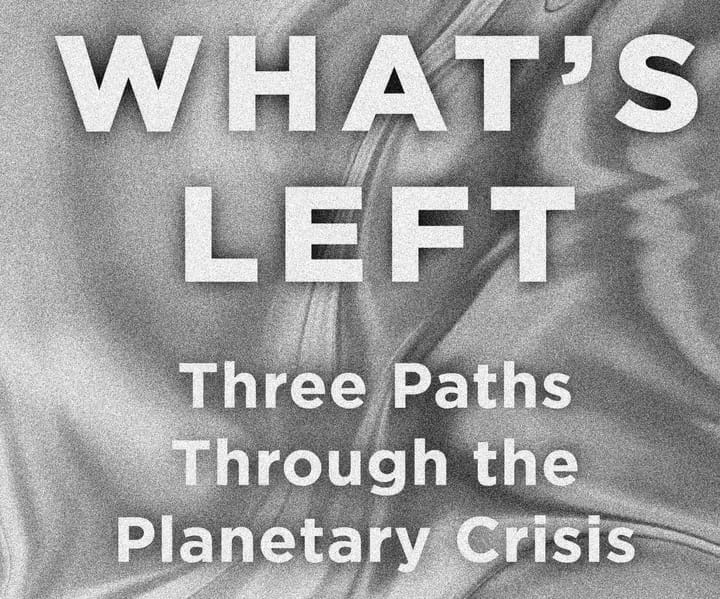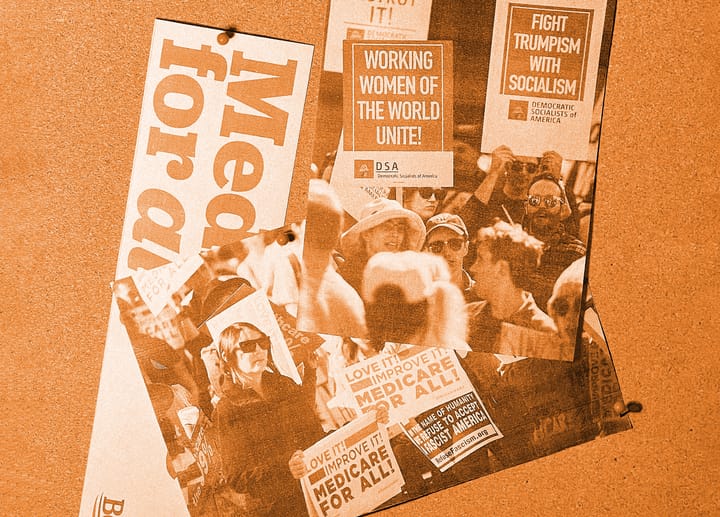A Death Sentence for the American Left?
Are Dylan Riley and Robert Brenner pointing to real impossibility or mere political limits?

The years bookended by the two Bernie campaigns were lots of fun. The rediscovery of mass politics through the unlikely character of Bernie Sanders infused a new generation of leftists with a sense of possibility. Medicare for All, College for All, a Green New Deal… these things were popular, and they seemed, if not fully within reach, at least visible on the horizon. Since the beginning of the Covid-19 pandemic and the abrupt fall into the “post-Bernie” moment, that possibility has all but evaporated. Reality once again seems static, and we are sadly facing it with sober senses.
Dylan Riley and Robert Brenner’s recent “Seven Theses on American Politics” in the New Left Review aims to wake any lingering Bernie dreamers to the uncomfortable reality of the present. In it, the Left’s illusions are punctured, and the true difficulty of our political impasse is laid bare. But just how immutable is our current reality, and by extension, how dire is the Left’s predicament? There is always the concern that painting bleak pictures is a performative gesture, and that difficulty is being reified as impossibility.
Before offering “a set of seven telegraphic theses, flanked by empirical evidence, intended to provoke further discussion of these critical questions”, Riley and Brenner set the stage by introducing a new term for the present “electoral structure”: political capitalism.
Under political capitalism, raw political power, rather than productive investment, is the key determinant of the rate of return. This new form of accumulation is associated with a series of novel mechanisms of ‘politically constituted rip-off’.
Examples include “Bush’s Prescription Drug legislation, Obama’s Affordable Care Act, Trump’s CARES Act, Biden’s American Rescue Plan, the Infrastructure and CHIPS Acts and the Inflation Reduction Act.” The theses regarding the underlying structure behind these “politically constituted rip-offs” are as follows:
1. A new non-class, but robustly material, politics has emerged since the 1990s.
2. Bidenism offers Keynesianism without growth.
3. The hypothesis of ‘class dealignment’ is an inadequate framework for understanding American contemporary politics.
4. The Democrats’ relative success in the 2022 midterms is a reflection of its particular social base.
5. The American left is in the grip of three illusions about domestic politics.
6. Positive-sum class compromise is impossible in the current period.
7. Bidenism’s natural ideology is progressivism, not social democracy.
To briefly categorize: thesis 1 offers some interesting observations on the nature of the working class in the United States, and usefully differentiates a class politics, where workers act and conceive of themselves as a class, from a non-class politics that nonetheless caters to material interests (the latter being a defining feature of political capitalism); theses 4 and 7 on Biden and the Democrats are fine, but uninteresting and somewhat disconnected from the others; thesis 2 on “Bidenism as Keynesianism without growth” does not get to the heart of the matter; and theses 3, 5, and 6 comprise a hearty slap in the American Left’s face. (In what follows, I’ll be mostly leaving theses 1, 4 and 7 to the side, though thesis 1 is deserving of further attention. I’m skeptical of Riley and Brenner’s overly brief delimitations on the “character of the US working class,” but it would take another article to fully engage them.)
In his own response to the essay, Tim Barker helpfully unpacks the term “political capitalism” (Maybe, but how about first a nod to the ways in which capitalism has always been political?), questions just how one-sided the examples they trot out truly are (Is the ACA only “politically engineered upward redistribution”?), wonders where the Marxist analysis is (Does the CHIPS Act now constitute a “mechanism of surplus extraction”?), and laments the caricatured portrayal of the Fed “as some kind of permanent conduit of the easy money desired by Wall Street.” It’s an insightful response, but it sidesteps the challenge offered to the American Left contained within the theses.
Theses 3 and 5 are pretty direct in this regard. At the same time that Jacobin releases an issue on dealignment, Riley and Brenner come out and say that the dealignment thesis inadequately accounts for the successful stoking of nativism and racism in the white working class:
This shift of white workers without a college degree to the Republican Party is best understood not as a process of class dealignment, but rather as the consequence of the GOP’s successful bid to appeal to the interests of a particular fraction of the working class in nativist and racist terms.
Riley and Brenner are able to reject the simplifying liberal belief that white workers are bad and racist by pointing out the “rationality” of exclusionary ideologies “in a context where class identity is nowhere evident.” But the implication is difficult to avoid here: Matt Karp (the theorist most associated with the dealignment thesis) and Jacobin have minimized the degree to which a racist and nativist appeal has muddied the political waters.
The first thing to note here is that even if it were true that white workers are voting on the material advantage that being racist gives them, this description merely describes one mechanism by which “dealignment” happens rather than invalidating the hypothesis as such. Riley and Brenner supply their own causal story for the same political result. A more significant shortcoming of the Riley/Brenner thesis about the rationality of exclusionary ideologies is that it ignores the question of why many workers, rather than go over to the Republicans, drop out of the political process altogether. For the Left, depoliticization is by far the more important fact about the present conjuncture.
But leaving the precise mechanisms of dealignment aside, the question remains: practically, what is the conclusion here? Is the attempt to “repolarize the population in class terms” simply futile because those who have gone over to the Republicans are bigots?
The challenge to the Left continues in thesis 5, which outlines three illusions to which the Left is subject: 1) “The obvious path to electoral success is to appeal to the American working class in ‘class terms’”, 2) “The Biden Administration has pursued timid, weak or disappointing domestic policies”, and 3) “Biden’s unpopularity and the party’s electoral struggles derive from his policy timidity” (a combination of illusions 1 and 2).
Of the first “illusion,” there is no doubt a slice of the Left that shames the Democrats for “irrationally pursuing a non-class strategy.” But the point of challenging the “corporate Democrats” is to get them out of office, not to lament why they are failing on their own terms. The American Left is many frustrating things, but in the places where it has seen some electoral success, it understands that power is at play, not a speaking of truth to it.
The second and third illusions are premised on the assertion that “no administration since LBJ has proposed the sort of domestic initiatives Biden has,” and that the Biden spending packages are much more ambitious than the Left has allowed. These arguments harken back to thesis 2 (“Bidenism offers Keynesianism without growth”). If the point is simply to offer an accurate portrayal of the magnitude of Biden’s initiatives in the face of a Left that unhelpfully paints them as “too timid,” fine. But Riley and Brenner fail to adequately tackle the quality of Biden’s interventions. As John Terese has written in these pages,
There is no question that the financial tap is on: who knows for how long, but massive state spending is back on the table. Yet so far this stimulus spending has gone directly from central banks to individual bank accounts or straight to corporations, with little to no strings attached; that is, the funds did not go to public works projects, public goods, or social services. This was justified by what Adolph Reed has called a “Wall-Street-Keynesian” logic of consumer sovereignty, a far cry from the New Deal ethos of world rebuilding, both socialist and nationalist.
Terese agrees with the criticism of the Left, but still thinks Biden’s form of “Wall Street Keynesianism” must be understood as qualitatively different from the program of long-term investment that the Left has formulated in the program of the Green New Deal, for instance.
What if the Left’s misgivings about the rising transfer state and its programs should be qualitative, not just quantitative? The old New Deal was a massive experimental program in a mixed economy and national development. Spurred on by a fractious but densely organized coalition between labor and small business, the Roosevelt administration did not just throw money at their problems; they invested in long-term public services, the electrification of rural areas, the building of dams, roads, bridges and other infrastructure. In its most ambitious moments, public money was spent to build public goods with very little private sector involvement. This kind of remaking of the economy for the public good has been so far completely absent from the policy toolkit of the crisis fighters. Instead, policy makers have opted to replace the invisible hand of the market with the invisible hand of the state: a referee who will occasionally assist the players but never partake in the game itself.
Here we get to the crux of the matter: Riley and Brenner do not differentiate between the Biden spending packages and long-term public investment because the latter is, in their view, impossible. From their essay:
Positive-sum class compromise is impossible in the current period. The basis of the welfare state, both in the US and Europe, has always been high profitability, and high rates of investment, in manufacturing. But manufacturing profitability and investment remain weak. (Even the supposedly most dynamic sectors of the new economy are in the throes of a crisis.) Political capitalism remains firmly in place, meaning that redistribution from capital to labor will be extremely difficult, if not impossible, because of the dependency of profits on politically engineered upward redistribution. It is perhaps this fact, above all else, that explains the sudden return of inflation. Inflation is what one gets when one pursues deficit spending in the absence of a dynamic capitalism.
Perhaps they mean that “Positive-sum class compromise is impossible without a change in the balance of forces today,” in which case this statement is an apt critique of a naive electoralism but somewhat irritatingly pessimistic about the possibilities for change in a system in crisis. The New Deal, after all, was a haphazardly swift affair.
But it’s also possible that thesis 6 should be read as “A change in the balance of forces is impossible in the current period.” Bidenism offers Keynesianism without growth, and in fact that is all Bidenism could ever be (despite its best intentions), given the constraints of political capitalism. If this is the case, what are we left to do? If we can’t recharge the manufacturing of things like electric vehicles and offshore wind turbines and maybe even nuclear reactors through public expenditure, how are we ever going to have a shot at solving the climate crisis? Is Mazzucato’s “crowding in” effect of public investment, pushed indirectly by a new working-class upsurge, truly impossible today?
This reading is consonant with Brenner’s longstanding emphasis on the great stagnation since the ‘60s and ‘70s: in his view, a decline in the rate of profit has “destroyed the precondition for the wage gains and welfare state reforms sought by trade unions and social-democratic parties.” But we now have a glaring counterfactual in the case of China: how was the Xi regime able to build out its rail network in the 2010s and get Keynesianism with growth? The fact that it serves as a growth motor for the Global South indicates that this cannot simply be a zero-sum game, with China only stealing from the rest. Beyond the entrenchedness of political capitalism, which most on the Left would agree needs to be overcome, what are the limits of American political economy that make this program impossible? (This is a real question: I’m open to the possibility that there are specifically American limits, but they need a fuller theory as to what’s hampering public investment.)
Again, thesis 6 lends itself to dual readings, but “Positive-sum class compromise is impossible in the current period” is a pretty large claim to be imprecise about, especially when its political implications are so potentially devastating. In any event, I’m uncertain as to what the political conclusions are. In Riley/Brenner’s world, the white working class has been hived off by racist appeals, Biden’s trying but constrained by political capitalism, and the silly Left thinks it can get a Green New Deal. There is an odd way in which Riley and Brenner have aligned themselves with the liberal establishment here, down to a lamentation of the fact that Biden doesn’t have a greater advantage in Congress. What BungaCast has called “Neoliberal Order Breakdown Syndrome” has made strange bedfellows on the American Left.
■
Dom King isn’t really sure what happened and would like some time to figure it out.



